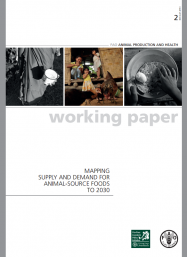
Mapping Supply and Demand for Animal Sources Food to 2030

Executive Summary Excerpt
Livestock is one of the fastest-growing sectors in agriculture, potentially presenting opportunities for economic growth and poverty reduction in rural areas, though unless carefully managed the main social effects may be negative – if the livestock-dependent poor are squeezed out of markets and are presented with few viable livelihood alternatives. There may be other negative outcomes to sector growth. A matter for recent concern has been the contribution that livestock make to greenhouse gas (GHG) emissions, for example, and there are public health implications of livestock production: the rapid spread of infectious diseases, typified by the recent and ongoing H5N1 avian influenza panzootic and the pandemic (H1N1) influenza A crisis, demonstrates the magnitude of problems arising from the emergence of novel diseases at the animal-human-ecosystems interface. Dealing with these important social, environmental and public health issues will require solutions that embrace the way in which the livestock sector grows to meet the increasing demand.
Given these important externalities to rapid livestock sector growth, it is important to understand where growth in demand for livestock commodities is likely to occur, and how and where production of livestock commodities will be increased in order to meet it
- Issues:
- Health, Demography, Urbanization and Migration, Natural Resources
- Region:
- Global
- Year Published:
- 2011
- Authors:
- Timothy Robinson, Francesca Pozzi
- Institutions:
- Food and Agriculture Organization (FAO), United Nations

